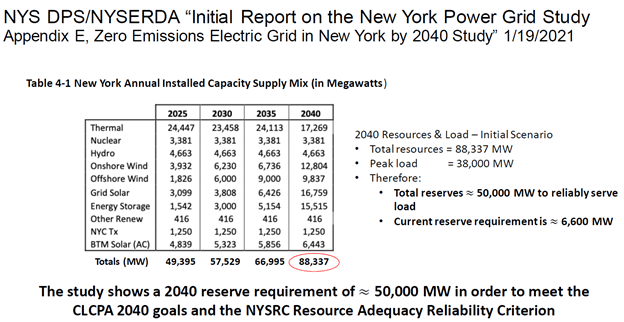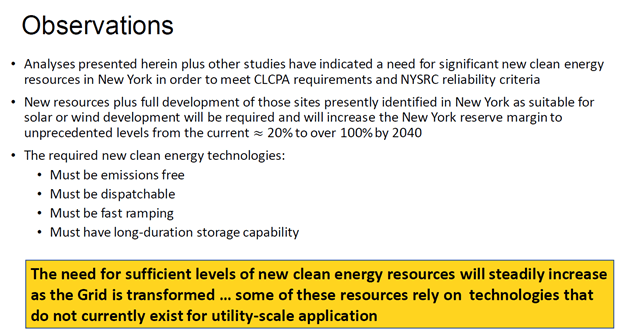This post was published at Watts Up With That on September 2, 2021
On July 18, 2019 former New York Governor Andrew Cuomo signed the Climate Leadership and Community Protection Act “Climate Act”), which establishes targets for decreasing greenhouse gas emissions, increasing renewable electricity production, and improving energy efficiency. Over the last year recommendations have been developed by panels of politically chosen representatives for consideration for a Scoping Plan to achieve greenhouse gas (GHG) emissions reductions economy-wide. On August 2, 2021, the New York State Energy Research and Development Authority (NYSERDA) held a Reliability Planning Speaker Session that provides some interesting insights regarding reliability planning for electric systems dominated by renewable energy generation.
Background
Reliability planning in New York is prioritized because there is a long history of blackouts in New York State in general and New York City in particular. After a blackout in July 2019 AMNY published a brief history of blackouts in New York City. In every case after blackouts in 1959, 1961 1965, 1977, 2003, and 2012 new requirements for infrastructure and operating rules were implemented to prevent future reoccurrences. Reliability planning is a constant concern for the electrical system professionals who operate the system and are responsible for keeping the lights on. With all due respect to the professionals who are trying to develop a reliable system that incorporates large amounts of intermittent and diffuse wind and solar generation, the track record for blackouts indicates that historically not all the problems could be anticipated and that retrospective reliability improvements were the norm.
Over the past year the electric system professionals have looked on the Climate Act transition process and recommendations with increasing concern because it is clear that many of the appointed representatives do not understand the particular reliability requirements of New York. After a year and many comments, the State finally responded with an overview briefing presentation on those requirements to the people who are supposed to guide the transition plan. The speaker session (recording here) included presentations from six organizations with varying levels of reliability background, experience, and responsibilities:
- New York State Reliability Council (NYSRC) – Mayer Sasson, Steve Whitley, & Roger Clayton
- New York Independent System Operator (NYISO) – Zach Smith
- Utility Consultation Group – Margaret Janzen (National Grid) and Ryan Hawthorne (Central Hudson)
- New York State Department of Public Service (DPS) – Tammy Mitchell
- Vote Solar – Stephan Roundtree
- New York Department of State Utility Intervention Unit – Erin Hogan
In a post on my blog I did an overview of all the presentations. The warning in five of the six presentations was similar: it will not be enough to depend on today’s technology to develop a reliable electric system with net-zero emissions. A “large quantity of installed dispatchable energy resources is needed in a small number of hours” and it “must be able to come on line quickly, and be flexible enough to meet rapid, steep ramping needs”. That technology does not exist for utility-scale applications. Unfortunately, in order to cater to the environmental zealots involved in the process a presentation from Vote Solar who claimed “integrating renewables into the grid while maintaining reliability is possible, and in fact cost effective” was included. That presentation was based on the report, “Why Local Solar for All Costs Less”, that is fatally flawed because it relies on annual estimates of renewable resource availability and does not address worst case conditions.
NYSRC Presentation
The presentation by the New York State Reliability Council succinctly describes the organization, how the New York electric system is operated to maintain reliability and some of the challenges presented when renewable energy sources are increased significantly. It was so well done I thought it would be of interest to readers here.
New York’s electric system is de-regulated so reliability planning is provided by the New York Independent System Operator, various state agencies and the NYSRC. The introduction describes the NYSRC and the Installed Reserve Margin (IRM) parameter. The IRM is defined as the “minimum installed capacity margin above the estimated peak load to meet the Northeast Power Coordinating Council (NPCC) requirement that the probability of shedding load is not greater than one day in ten years”. Load shedding occurs when the demand for electricity exceeds supply and grid operators have to turn power off for groups of customers in order to prevent the whole system from collapsing. Note that one of the lessons learned from previous blackouts was that New York City has to maintain a significant amount of in-city generation availability to prevent blackouts. The NYSRC has specific rules in this regard.

The next slide described how the system is operated reliably. Note that in addition to the short-term operation of the system that longer term planning is also required. In order to address the one in ten-year criteria of the IRM, planning has to address new generation and transmission resource development that can take ten years to get built.

The slide titled “Operating the future system reliably” explained that as the mix of generation resources changes, planning and operations will also have to change. A point of emphasis is that “Limited fuel diversity and over dependence on energy limited resources is a risk to reliability”. In the past New York boasted a truly diverse fueled electric system with significant coal, residual oil, natural gas, hydro and nuclear resources. There were significant resources available from sources that could store fuel on-site and could operate with more than one fuel. However, the state has banned the use of coal and residual oil has become so expensive that its use has dropped precipitously. The conclusion in the slide that additional dispatchable and sustainable energy resources to manage the substantially different system in order to maintain reliability refers, in part, to the New York City requirements for in-city capacity. Presently, for example, that means facilities must be able to burn oil when natural gas is unavailable.

The next slide (not shown here) re-emphasizes the importance of the IRM which turns out to be a future challenge when there are significant increases in renewable resources. This is illustrated in the slide titled “Solar impact on resource adequacy”. The slide shows the diurnal variation of load vs solar generation also known as the “duck curve”. Typical discussions of the duck curve focus on the operational challenge resulting from the loss of solar generation at the same time the load is high. This slide addresses the changes in the reserve requirements with the addition of 26,000 MW of new solar generation in New York. Because of the enormous variation in available energy from solar, adding that amount of solar generation would raise the reserve requirement to approximately 22,000 MW as compared to the current reserve requirement of 6,600 MW. It also means that the state can only retire 4,000 MW of current resources.

The Climate Act has an electric system target of zero emissions in 2040. The Department of Public Service (DPS) and New York State Energy Research & Development Authority (NYSERDA) have made a preliminary estimate of the resources needed to meet that goal as shown below. The key numbers from this slide are that they expect to need 88,337 MW in 2040 for an expected load of 38,000 MW. In order to meet that load and with a loss of load expectation no greater than once in ten years the NYSRC estimates that the total reserves will be approximately 50,000 MW.

The presentation observes that the New York reserve margin will have to increase to over 100% relative to the current reserve margin of about 20%. The estimates of resources needed to meet the Climate Act targets have not incorporated this issue so they under-estimate the resources needed significantly. In addition, the new technologies have to be zero emissions and meet the characteristics of fossil fuels (dispatchable, fast-ramping, and long duration storage). The presentation notes that “these resources rely on technologies that do not currently exist for utility-scale applications”.

Conclusions
I recommend reading the session presentation and listening as it gives a good overview of reliability issues facing New York or any other jurisdiction in the transition to net-zero. One caveat is to not waste your time reading the Vote Solar presentation because it is based on fatally flawed analysis.
There is consensus that the future worst-case situation in New York will be a multi-day winter time wind lull when both wind and solar availabilities are low. Coupled with increased electricity load in order to reduce emissions from transportation and heating, any analysis of future renewable energy resources that adequately addresses the worst-case renewable energy resource availability shows the required amounts of wind, solar and energy storage will have to be enormous. Importantly, the NYSRC analysis indicates that in order to ensure reliability the installed reserve margin will have to be added to the total needed to balance anticipated load. While the focus of the highlighted presentation was New York, I believe that similar problems will become evident at any other jurisdiction that attempts to develop a net zero emissions electricity system.
The NYSRC conclusion that the state of New York appears to be headed down a transition path which will require reliance on technologies that do currently exist in less than ten years should be a wake-up call. The ultimate question is whether the proposed transition plan will address the issues raised by the professionals or cater to the naïve dreams of the politically chosen members of the transition program. I fear New York consumers will be lab rats for a politically motivated virtue signaling empty gesture that is going to cost enormous sums of money, and, in the event of a major blackout, cause much more harm than good.
—————————————————————————————————————————————
Roger Caiazza blogs on New York energy and environmental issues at Pragmatic Environmentalist of New York. He has written extensively on implementation of the Climate Act because the solutions proposed will adversely affect reliability and affordability, will have worse impacts on the environment than the purported effects of climate change, and cannot measurably affect global warming when implemented. This represents his opinion and not the opinion of any of his previous employers or any other company with which he has been associated.

4 thoughts on “Reliability Challenges in Meeting New York’s Climate Act Requirements”